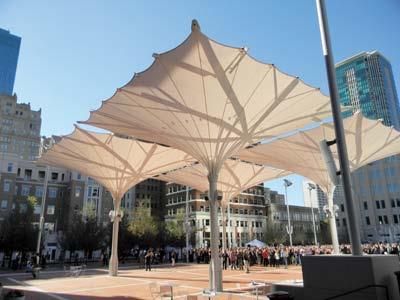The umbrellas at Sundance Square Plaza. Photo by Robert Francis
By Scott Nishimura Special to The Business Press
More downtown educational institutions, residents, public transit usage, and emerging businesses, and the establishment of a major “geotechnical institute” drawing off of the energy industry, are key pieces of Plan 2023, the once-every-10-years revision of the strategic plan crafted by Downtown Fort Worth Inc., the city of Fort Worth and the Fort Worth T. Downtown Fort Worth Inc.’s board is expected to approve the plan (http://dfwi.org/what-we-do/projects/plan-2023)Thursday, forwarding it to the City Council for a Dec. 3 vote to include it in the city’s comprehensive plan.
The plan’s focus has changed significantly over the years, with 1993’s focusing on the “audacious goal” of persuading people to live downtown, said Andy Taft, president of Downtown Fort Worth Inc. “This one, we’re talking about schools,” Taft said in an interview Tuesday. “So you can see the progression.” Downtown leaders were optimistic they’ll be able to put the tenets of the plan into action over the next 10 years, citing a string of accomplishments that have come out of previous plans dating to 1993. “We’re able to get things done even when it’s a decades-long project to come together,” Johnny Campbell, Sundance Square president and DFWI chair, said last week during an unveiling of parts of the plan. Allan Howeth, a DFWI director and longtime Cantey Hanger lawyer, said the downtown plans differ from many other master plans that go “on the shelf.”
“We’re very hopeful that this will guide us,” he said during the unveiling party at Sundance Square’s new plaza. The plan calls for expansion of downtown’s “traditional business clusters,” to include more life sciences, research and development labs, insurance carriers, health care providers, consultants, manufacturers and clinics. “Downtown sits between the hospital district and the medical school”(the University of North Texas Health Science Center), Taft said. “You’ve got this uninterrupted corridor. You could consider it a biomedical crescent.” The geotech institute, besides working with downtown energy companies and experts, would collaborate with the TCU Energy Institute and the goal would be to establish Fort Worth as a “world geotech innovation center,” Taft said. “We believe Fort Worth is uniquely positioned to capitalize on the geotechnical expertise that works here,” Taft said. The plan calls for the continued maintenance of what Taft called “very sophisticated premium office space” downtown, but it also proposes to find ways to encourage startups and other businesses with creative intellectual capital downtown, Taft said. Other model cities have used incubators, angel funds, and facilitation of networking, he said. “We want to make them feel comfortable downtown,” Taft said.
The plan includes the potential expansion of the Fort Worth Convention Center – under study today – to expand the meeting market. “In the next 10 years, we need to approach the expansion of the convention center and look at that in a very thoughtful way,” Taft said. The plan calls for 2,500 new residential units in the central business district over the next 10 years, and 7,500 in “Greater Downtown,” which includes West 7th, the near South Side, the oncoming Trinity Uptown, and the “near East” around Interstate 35 and closer in, Taft said. Downtown currently has an estimated 3,000 residential units .The units are about two thirds rental, and one third condo, Taft said. With lending conditions better today for leased properties, Taft said, “we would probably see more rental housing built to condo standards.” But as conditions change, “I think we’ll see quite a few of those units built as apartments converted to condominiums.” Besides the geotech center, the plan also calls for:
• The establishment of more downtown schools to draw more residents, building on assets such as the Fort Worth schools’ incoming Young Women’s Leadership Academy, the Texas A&M Law School, and Tarrant County College and University of Texas at Arlington campuses. Of residents living downtown, 9.2 percent said in a 2011 survey they had children. • A digital media academy within the Fort Worth schools’ planned $17 million science, technology, engineering and math academy planned downtown and funded by voters in the Nov. 5 bond election. • The creation of a “maker space” downtown, harnessing the talents of “very creative smart people” who gather in clusters in other cities and “push the boundaries,” Taft said.
Such clusters are growing in Tarrant County, and may meet in such low-key spots as restaurants, Taft said. The downtown team has been noodling with a group of them, he said. “They don’t have a space; we have identified a free space downtown,” Taft said, declining to elaborate. Downtown development should continue in a way that improves “walkability,” with “no large gaps of unpleasant pedestrian experience,” Taft said. Plan 2023 also says that transit authorities and downtown need to develop a “comprehensive central city transit strategy,” with connections to rail at the Fort Worth Intermodal Transportation Center and T&P Terminal. The plan establishes a goal of increasing T bus ridership by 30 percent through downtown, a “not insignificant” number, Taft said.






